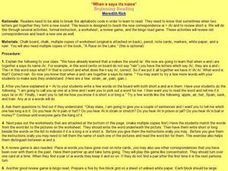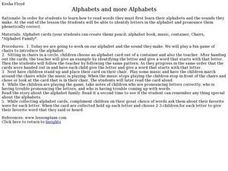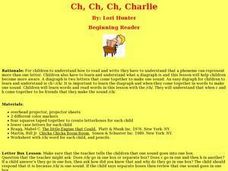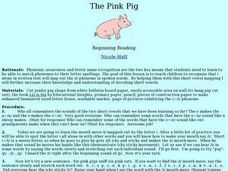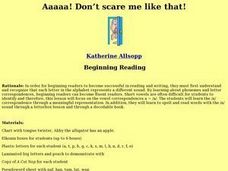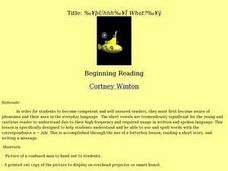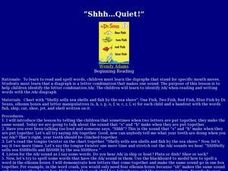Curated OER
Buh, Buh, Buh B!!
Students complete a variety of activities related to the letter "B." As a class they recite a tongue twister, then trace and write the letter "B." Students identify the words in the poem that contain the /b/ sound and draw a picture of...
Curated OER
Open Up and Say /o/
First graders listen to a variety of words to see if they can recognize the /o/ sound. They use letterboxes and letters discovering that each mouth moves gets its own box practicing forming words with the /o/ vowel sound. They then read...
Curated OER
When A Says Its Name
Students are introduced to the concept of vowel digraphs. They identify the digraph /ai/ in spoken language. After a brief discussion, students apply the rule for reading and spelling words containing the /ai/ digraph by playing word bingo.
Curated OER
Alphabets And More Alphabets
Students identify and phonetically pronounce the letters in the alphabet. They participate in a letter identification game, and play musical letters. Students then listen to the book "Alphabet Family" and discuss their favorite words...
Curated OER
Choo Choo Train
First graders study the sound and spelling of the /ch/ digraph. They repeat words containing the "ch" before making words using their Elkonin letterboxes and letter manipulatives. Next, they clap each time they hear the "ch" digraph...
Curated OER
Voicing and Syllable Length (Using Rubber Bands)
High schoolers identify voiced and unvoiced sounds. They practice using short and long vowel sounds. They identify consonants only after paying attention to the length of vowels. They use rubber bands to help them determine the...
Curated OER
Ch, Ch, Ch, Charlie
Students explore the /ch/ phoneme and how it just a combination of the /c/ and /h/ sounds. They recite /ch/ tongue twisters and write 'ch' words using letterboxes. They identify /ch/ words while reading the story, 'Chica Chica Boom Boom.'
Curated OER
Ehhh! What'd ya say? Eeeggs
Students identify the vowel sound with a short e. They distinguish this sound /e/ in written and spoken words. Finally, students identify and spell using a letterbox lesson and reading various words with the vowel sound and are...
Curated OER
MMMM MMMM Yummy Cake
Students identify the letter "m" and its sound in this activity. They identify foods that contain the /m/ sound by making a "m" sound. They then listen to the story Stand Tall Molly Lou Melon and identify the /m/ words in the story.
Curated OER
The Pink Pig
Students identify the short /i/ sound in spoken words and the letter symbol in this lesson plan. They say a tongue twister emphasizing words with the short /i/ sound. They then read the story "Liz is Six" and identify the words with...
Curated OER
Spelling and Thinking/ Short a
Learners participate in a instructional activity that is concerned with the usage of spelling words that has the short "a" sound. They read the words in list form. Students also write the words in the "an" and "ad" word families.
Curated OER
Aaaa! Don't Scare Me Like That!
Students practice saying each letter of the alphabet to determine the different sounds from each letter. As a class, they are given a tongue twister to practice making the "a" sound and spelling the words. To end the lesson, they...
Curated OER
Alphabet
Primary learners will make posters, trace letters, and eat letter cereal, all to learn about the alphabet. They will also go on a scavenger hunt around the room looking for letters. This resources has lots of ideas for bringing about...
Curated OER
Uhhh..What?
Students identify and become competent and in reading the letter u, pronounced /uh/. They also use and spell words with the correspondance u = /uh/ by the use of a letterbox lesson, reading a short story, and writing a message.
Curated OER
Shhh! Quiet!
Students become aware that when certain letters are put together in a word they are said with a single mouth move. Through modeling and a variety of guided practice activities they explore the /sh/ phoneme. They read and identify 'sh'...
Curated OER
Uhh I don't know!
Learners engage in an emergent literacy lesson in order to work on the skill of phonem ic awareness. The use of flashcards is essential for the instruction of the lesson. Students match the card with its beginning phoneme.
Curated OER
Sammy the Slimy Snake
Students engage in a emergent literacy lesson with the intention of improving reading comprehension. The goals of the lesson include recognizing both upper and lower case S, to create an awareness of the mouth movement and the phoneme...
Curated OER
"Tongue Tangle"
First graders engage in a study of phonics that focuses on the beginning sounds with an emphasis upon varying types of genres that includes songs, speech, and poetry. They recognize the beginning sounds of words and make physical...
Curated OER
Making Words - With A Twist
Students take a scrambled word and try to make other words using all of the letters. They form words out of playdough as well.
Curated OER
ESOL: Pronouncing Multi-Syllable Words
Twelfth graders in an ESOL class discover where to place the stress in multi-syllable words. Through drill and practice sessions they identify a variety of stress patterns for words containing multi-syllables. In pairs, 12th graders...
Curated OER
Pronunciation of Final Consonants
Students in ESOL classes discover how to recognize and pronounce final consonant sounds. With partners, they read passages aloud and practice the correct pronunciation. Students emphasize pronouncing the final consonant and attempt to...
Curated OER
Pronunciation of /aw/ Diphthong
Students comprehend how to produce this pronunciation feature, notice the spellings, hear the sounds, produce them correctly when thinking about it, and practice correct pronunciation to be comprehended by others. They work with a...
Curated OER
The Joke's on You!
First graders share and create jokes to promote and enhance reading skills (fluency, emphasis, timing and sight word recognition), acquire vocabulary and recognize homophones. Students read their jokes aloud, concentrating on voice...
Curated OER
Sound Search (Elementary, Reading/Writing)
Pupils learn initial sound recognition by walking through the school and its grounds looking for items that begin with the same sound as their first name.




